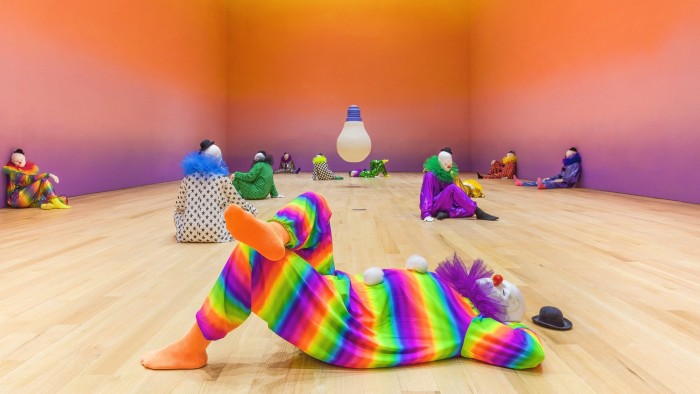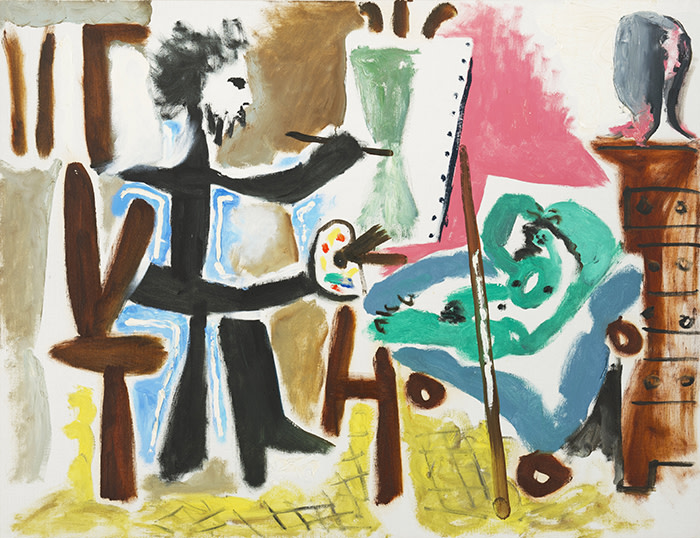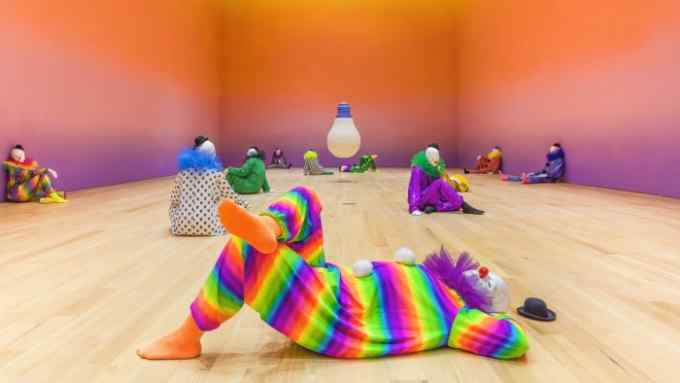Culture shock and clowns: Bass Museum and ICA Miami reviewed

Roula Khalaf, Editor of the FT, selects her favourite stories in this weekly newsletter.
There’s a word for it: coulrophobia. Fear of clowns. It isn’t clear whether Swiss artist Ugo Rondinone’s giant room of 45 highly realistic, life-sized clowns slumped on the floor and against the walls at The Bass Museum in Miami — entitled “Vocabulary of Solitude” — is designed to inspire a macabre sort of fear, to raise a smile or to invoke tenderness and even pity. Perhaps all of the above. Clowns they may be, but the artist is using them to illustrate the simplest human functions: breathing, tasting, yawning, lying down, dreaming and more. The clown, we suppose, is the performer we all have to be, in our outer lives, gaudily got up to face the world while the simplest urges really drive us, and consume our moments alone; also perhaps the performer that is the artist, communicating through a set of masks and conventions.
Several lofty spaces on the museum’s top floor continue good evening beautiful blue, the overall title of this Rondinone retrospective. A six-screen video work is another intimate investigation of solitude, small actions, and disengagement with outside realities. Similar themes are invoked by “clockwork for oracles II”, a room of 52 window frames set with coloured mirror glass hung on newsprint: we see ourselves refracted, isolated, framed apart from the urgent concerns of the day.
It is a powerful choice by the curators with which to launch the newly reopened Bass Museum, showing off its impressive $12m facelift. From the outside, the chunky-brutalist Art Deco building, sitting in its grove of giant trees, looks the same: the neon sign over the entrance still reads “ETERNITY NOW”. Inside, however, there is quite a transformation, with clean lines and spacious clear pathways into a range of differently sized galleries.
Downstairs, Belgian-Cameroonian artist Pascale Marthine Tayou’s Beautiful is a luscious riot — columns made of painted cooking pots, pictures constructed of thousands of sticks of coloured chalk with embedded toy figurines, sculptural heads using glass, socks, forks, hessian and string — all set among the conventional artistic treasures of the museum’s permanent collection. On the walls are glued thousands of brightly coloured alabaster eggs, as if we are in a giant sweet shop. Actually we are in a lesson, here, about cultural clash and cultural crossings, about colonialism and its perils and riches; we are being persistently if gently teased about our taste for the exotic.
Across other downstairs rooms is the world of Mika Rottenberg, an Argentine installation and video artist who shines a hard light on the costs and excesses of materialism. A plastic lettuce; a rubber carnival snake; disembodied ponytails that flick repetitively out from the blank wall; a video in which women endlessly sort mountains of pearls; another in which coloured lightbulbs are whacked into gleaming shards by a hammer-wielding hand, before the shards morph into super-pretty tinsel decorations that threaten to drown the sad-faced women who work among them. Rottenberg uses playfulness and a sense of the absurd to drive home a sometimes grim message.

The Bass is just one of Miami’s new-minted institutions. Across town in the super-slick Design District (“OK, so turn left at Gucci, then right at Prada,” were my directions from a helpful passer-by), the pixelated shiny-silver façade of the new-built, 37,500 sq ft ICA Miami opens into a generous, high lobby that looks out to a sculpture garden beyond.
This amazing creation, which came into being after a troubled history of boardroom battles, was designed by the Madrid-based firm Aranguren + Gallegos Arquitectos. The design and construction was funded by Norman and Irma Braman; Irma is co-chair of the museum’s board.
The mood is relaxed. Downstairs, leisurely spacious galleries address cultural diversity — de rigueur everywhere in the arts, of course, but eloquent in Miami’s melting-pot: Chris Ofili beside Robert Gober, the African-American abstract installationist Senga Nengudi, the bizarreries of Edward and Nancy Kienholz, the southern continent represented by Hélio Oiticica and Haiti-born, Miami-based Tomm El-Saieh, with large, intense spatter-work canvases.
Up to two enormously spacious floors, with diffused daylight from an entire glass side, is The Everywhere Studio, an intelligently partitioned and curated group show of some 50 artists on the theme of the studio, from the postwar era to today. Or rather, not quite on that theme . . . the curators’ mission is to show how the traditional studio, with all its readings of the artist’s personality, has changed with the advent of different media and modes of production.
So here are views we’d hope for — two fabulous Picassos (the model and the studio were of course among his favourite themes), a fine 1974 Roy Lichtenstein of painter and model, Philip Guston’s beguiling pile of boots blocking a doorway. Some works are specific — Rosemarie Trockel’s memory-laden paint-spattered easel “O-Ton” — others, such as Yves Klein’s beautiful blue smudges, allude to the means of production in a more abstract way.
Moving into the contemporary, the subject range widens: now memory, onscreen allusions to work planned and done, even basic notions of home are encompassed in the mind-expanded studio-that-is-everywhere. It’s a show that would have been stronger for being smaller: some less interesting work could have been pruned out. While powerful artists have always made intensely meaningful and fascinating work on this theme, in lesser talents it starts to look merely self-regarding.

Comments